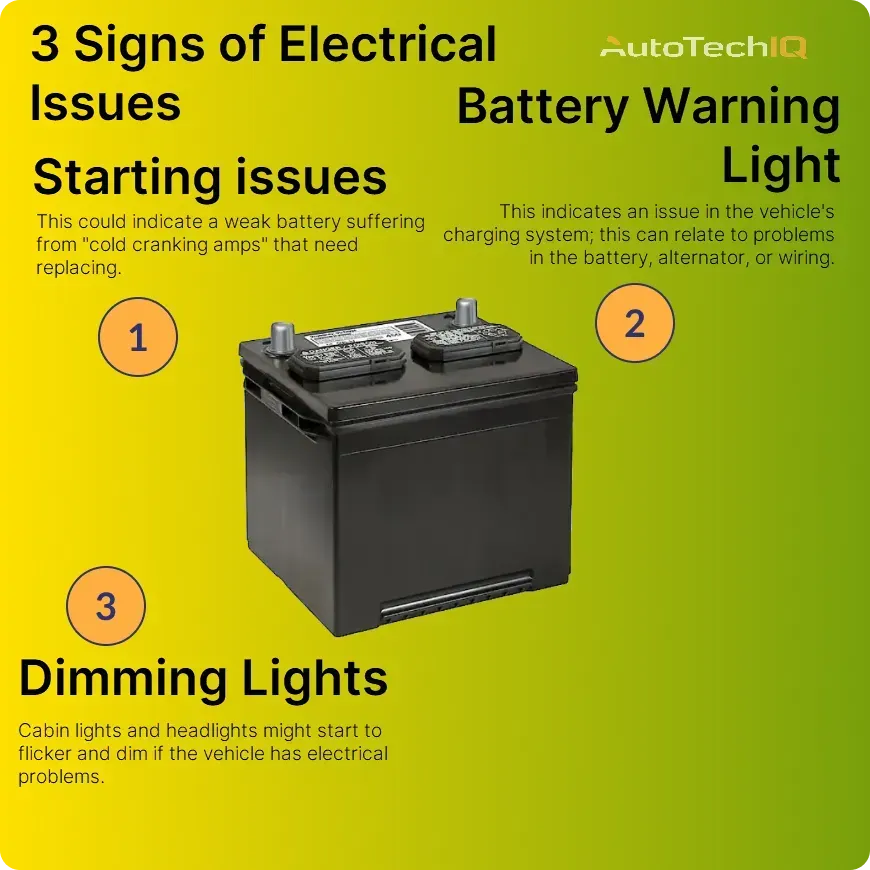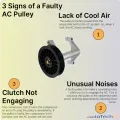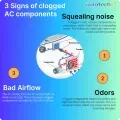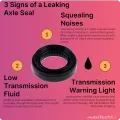

Electrical issues can happen anytime in your vehicle, and there are many. The main sign your vehicle is having electrical problems is a battery warning light popping on the dashboard.
Your vehicle's electrical system involves the battery, alternator, belts, and various accessories, all connected through a lengthy "web" of wires transmitting power.
- Key function: Your vehicle's electrical system aims to provide safety, comfort, and functionality. Modern vehicles feature many technologies like power steering, driving assistance, LED lights, automated controls, etc., all depending on battery power. Therefore, the electrical system is vital to keep a car running reliably.
A vehicle with electrical issues can have a serious loss of safety.
- Safety: Since vehicle electrical systems like power steering, stability control, traction control, ABS, etc., are all safety-related and depend on the electrical system, electrical problems will impact their work. Therefore, without these technologies that require power and electricity in a car, the vehicle loses safety and reliability.

Battery warning light
Most vehicles will feature a battery warning light if the electrical system has an issue that affects the charging system. The warning light pops up because the charging system is part of the electrical framework.
The vehicle picks up on this because it has a computer that's constantly measuring the voltage in all electrical properties. This computer is called the Engine Control Unit.
The Engine Control Unit (ECU), is the vehicle's computer that monitors the voltage in the electrical system. This computer warns whenever the voltage is different than it should be, indicating a problem with the charging system.
For example, the voltage will be below the normal range if the alternator or some wiring is faulty. This triggers the ECU to activate the battery warning light on the dashboard.
Dim or flickering lights
Electrical issues commonly cause vehicle lights to flicker and dim, due to improper electricity flow. Both headlights and cabin lights of a vehicle depend on the battery, alternator, and wiring. Therefore, the lights can go faulty if any of the systems they depend on develops an issue.
Since the systems the lights depend on belong to the electrical system, problems in electrical components commonly impact them. Consequently, dimming or flickering lights are a common sign of electrical issues in a vehicle.
Other signs
- Loss of power steering
- Burning smells (plastic, rubber)
- Starting problems
- Unusual sounds
- Corroded/Loose battery terminals
- Radio issues
- Blown fuses
Possible fixes
Your vehicle might need one or a few of these replacements, depending on the mechanic's investigation:
- Blown fuses replacement: Blown fuses need replacing because they indicate an overload or short circuit in the electrical system that disrupts power flow. This might also involve replacing the fuse box if the issue caused burning plastic.
- Starter motor replacement: A faulty starter motor needs replacing to ensure the spark plugs get the initial push to start the engine properly.
- Battery replacement: Replacing the battery and battery cables is necessary when it can no longer hold a charge or provide sufficient power to start the vehicle and operate electrical components.
- Alternator replacement: The alternator needs replacing if it fails to charge the battery and power the vehicle's electrical systems while the engine is running.
- Wires replacement: Replacing corroded or faulty wiring is crucial to restore proper electrical connections and prevent short circuits.
- Computer software calibration: Calibrating the computer software ensures the vehicle's electronic control units function correctly and efficiently.
- Computer or module replacement: Replacing a faulty computer or module is essential to restore the proper operation of various vehicle systems and components.
Frequently Asked Questions
How do you tell if your car has a short circuit?
A short circuit in your car's electrical system can show itself through flickering lights, electrical components acting strangely or blowing fuses repeatedly. You might also hear a buzzing sound or smell burning plastic, but for your safety, any of these signs warrant a visit to a mechanic to diagnose the problem before it damages more components or even starts a fire.
Can you drive a vehicle with electrical issues?
It's generally not advisable to drive a car with an electrical problem. Electrical problems in cars can impact critical functions like starting, steering, and braking, making it unsafe. Even minor problems can worsen while driving, leading to a breakdown or even a fire. Play it safe and get your car checked by a mechanic before getting behind the wheel.
Can electrical issues in a car be fixed?
Yes, electrical issues in a car can often be fixed! While some complex problems might require a mechanic's expertise, many common fixes involve replacing a dead battery, blown fuse, or faulty component. Various electrical components in modern cars are plug-and-play to facilitate replacement. If you're unsure about the cause, it's always best to err on the side of caution and have a professional diagnose and repair the issue to ensure your car runs safely and efficiently.
Other news
-
Car is Squealing When Driving

-
What is Preventative Maintenance and What Are The Benefits of it?

-
JobViewIQ - DVI Process Training - Part of the Auto Care Alliance Benefits

-
7 Signs of AC Pulley Issues

-
7 Signs of Clogged AC Components

-
How Much Does a Transmission Fluid Change Cost?

-
7 Signs of a Leaking Axle Seal
